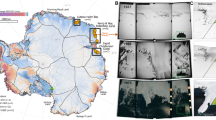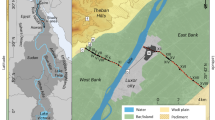Abstract
During my stay in the Engadine this summer I took the opportunity of making a few observations relative to the movement of the Morteratsch Glacier, which may be of interest to some of your readers. These observations were taken inside the artificial cave of the above glacier in preference to the surface, as I thereby obtained a more direct measurement with a fixed point, as will be shown presently, and greater protection for the provisionary stations, made in the ice, against disturbances of fluctuating temperatures or the curiosity of visitors. The arrangement was very simple, namely: in the roof of the cave 2—3/4 in. round staves 2 feet long were fixed, at a relative angle of 45°, in such a way, that they prevented each other from dropping out, and were further clamped together by a small metal band, from which a plumb-bob was suspended. Below this, on the floor of the cave, was a boulder, firmly embedded in the earth, and unaffected by the ice; this constituted my fixed point, a line being cut on it to correspond with the centre of the bob. In this way any movement of the staves with the ice could easily be measured off. The following are some of the results obtained, and I would draw special attention to the fact that, although the valley narrows considerably towards the snout end of the glacier, and in consequence one would expect an increase in the flowing speed, the observations prove a decrease in speed to nearly one-third. Movement in cave from August 1 to September 18, or forty nine days, max..354 in., min..093 in., mean.176 in. per day, (The surface movement taken at side of glacier, three-eighths of a mile from snout, up the valley, amounted to.516 in. per day.) End of glacier receded in the same time 19 ft., or 4.65 in. per day. Ice advanced 81/4 in.; total loss in length 18 ft. 33/4 in., or nearly 4.5 in. per day. I must add that the point of observation was fixed at 40 ft. from the entrance, as beyond that and further in the cave the floor formed part of the glacier, and no fixed station could be found. Also, the surface friction of the ice on the shore—both at the side of the glacier, where the surface measurements were made, and at the cave—was considered about equal, and could therefore not account for the great difference of movement.
This is a preview of subscription content, access via your institution
Access options
Subscribe to this journal
Receive 51 print issues and online access
$199.00 per year
only $3.90 per issue
Buy this article
- Purchase on Springer Link
- Instant access to full article PDF
Prices may be subject to local taxes which are calculated during checkout
Similar content being viewed by others
Rights and permissions
About this article
Cite this article
LEUPOLD, H. The Morteratsch Glacier. Nature 25, 77–78 (1881). https://doi.org/10.1038/025077c0
Issue Date:
DOI: https://doi.org/10.1038/025077c0
Comments
By submitting a comment you agree to abide by our Terms and Community Guidelines. If you find something abusive or that does not comply with our terms or guidelines please flag it as inappropriate.



